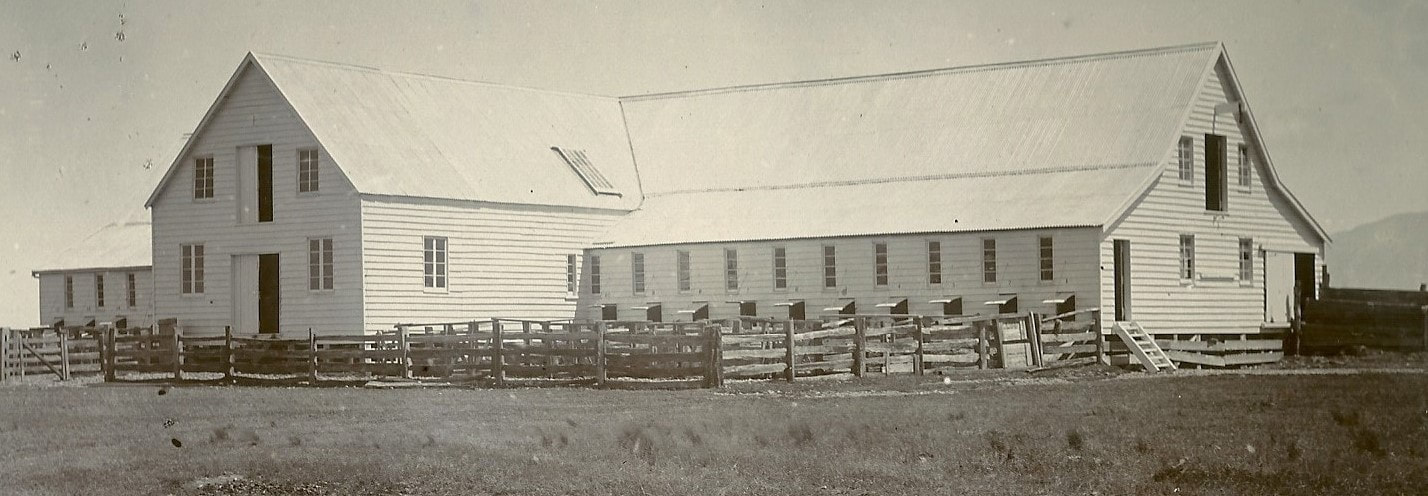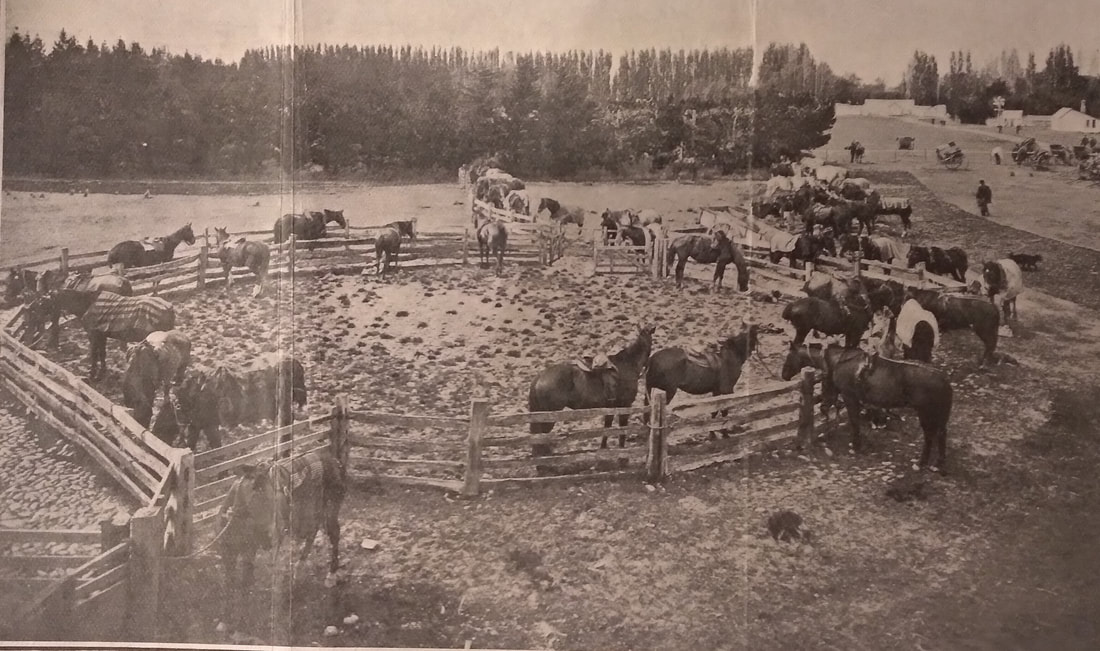FARM BUILDINGS
THE WOOLSHED

This significant building has a category 2 registration from the New Zealand Historic Places Trust. Plans, which exist in the Terrace Station Archives, were drawn up in 1867. It was built from native timbers, Totara and Matai, milled at Little River. The timber went along a bush tramway to Lake Forsyth, was floated across the lake then taken by another tram track to Lake Ellesmere. It was then pulled by a steam-powered tug across Lake Ellesmere to Timber Yard Point near Lakeside. One or two men from Rakaia Terrace Station made more than100 trips between May and November 1868 to bring back the timber on drays pulled by bullocks. Two employees, Tom Piecry and J Milne, are noted in the Station Journal as staying overnight at Lake Farm.
Construction took place in 1869, painting began on October 21 and the building was ready for the first shearing. The roofing was VDL shingles which were covered by corrugated iron in 1895. The building is approximately 38 metres long by 14 metres wide with a loft running the full length for storage of up to 250 bales. A woolroom juts out from the centre of the building and was extended by 3.6 metres in 1883. There were stands for twenty shearers.
A large circular holding yard was built, with a 2 metre-wide ramp leading into the shed for sheep access. As the shed is 1 metre above the ground, much soil had to be carted and paving was done with evenly-sized river boulders brought to the site and carefully laid. The posts and rails came from a bush block in the Glenroy area, owned by the station to provide timber and firewood. Bullocks were used to bring back the many loads and once back at the station the posts had to be morticed ready for the rails to be inserted. This was a very time-consuming job.
The first shearing in the new woolshed took place, six days a week, from January 6 to 25, 1870. As well as up to 20 shearers to be fed, there were the permanent employees on the station and extras for shed work – two men picking fleeces, two men rolling wool, one man tying wool, three men pressing. 43 sheep were killed during this time for mutton and two cooks were busy providing meals for 35 – 40 people each day. 28,000 sheep were shorn. The rate for shearing was 15/- per hundred ($1.50). A Clarke, one of the cooks, was paid 20/- ($2.00) per week and he bought from the station store 1 pair trousers @10/6 ($1.05) and 1 pair boots @ 15/6 ($1.55). Shears were 5/- (50c).
In order to get bales of wool to the loft for storage, a windlass (built into the rafters) is used. A wooden wheel 1.2 metres in diameter is on the end of a round wooden beam 200 mm in diameter. Around the big wheel is an endless rope that comes down to the ground floor. A hook is attached to a long rope which is wound round the beam. After being pressed on the ground floor, the bale of wool is placed beneath the windlass with a rope strop round it. The hook is attached to the bale strop and one young man can lift the bale of 150kg or more by pulling on the endless rope. The bale is lifted through two hinged doors in the floor of the loft. These close, the bale is lowered and then taken by sack barrow to be weighed, branded and stored.
In 1905 a Wolseley shearing plant was installed with stands for 16 shearers. It was driven by a White stationary engine. In the 19th century the station was famous for the size and quality of the wool clip. Two 5 feet-diameter flywheels were part of the engine that drove the overhead shafting which extended along both boards and provided for 16 machine stands. A lean-to addition to the shed was added. Within this addition the ‘shearing shed expert’ had a workbench and lockers for the handpieces. He was employed to attend to the grinding of combs and cutters and keeping the handpieces in good working order.
The first shearing with machines started on 28 November 1905 and was followed by very wet weather which slowed the progress. During the next eight weeks there were 24 days with rain and the final day of shearing was 23 January 1907. On some wet days there was a backlog of wool to be pressed and on one day the fleece pickers and sweepers were taken with Thomas Barson, the gardener, to the churchyard in Hororata to weed the paths. Other employees were recorded as ‘idle’.
Sir John Hall noted in his diary: ‘sheep even more cut about than with hand shears. Dunn, shearer, cut off tip of his little finger – went on shearing. I did all I could for him.’ On 23 December, Hall notes the storms and constant rain: ‘In Plummers paddock shepherd Stockwood with shorn hoggets till 11 p.m. but 30 died under his eyes. Begin to be sorry I introduced machines.’ However the shearing was completed with 26,679 sheep shorn averaging a clip of 8lb 7½ oz (3.8kg).
Electricity came in 1930 so an electric motor was installed to provide for six stands.
THE BLACKSMITH'S SHOP
In 1868/69 a blacksmith is recorded in the station journals as coming up by the day every week or so, perhaps from Hororata. It seems there was a smithy here, as 30 November 1869 a journal entry records, 'Bryan paving in front of smithy'. From the mid-1870s, a permanent blacksmith was employed for shoeing horses and making repairs to farm equipment. William McSweeney worked for the Halls for over twenty-five years and most of that time he specialised as the blacksmith. The handle of the bellows has worn smooth with use.The names of some of the hands are scored in the woodwork. The smithy had major restoration work done in 1990 and the forge was rebuilt in 2011
THE MANAGER'S HOUSE
The manager was a crucial person for the successful operation of the property. John Fountaine, who is recorded in the station journals from 1865, was the longest serving manager, being employed in that role between 1869-1899. It seems that the first part of the building was probably constructed from imported Australian timbers, as was the first part of the homestead. Originally it was shingled and later covered with corrugated iron. The manager's house was enlarged and added to on several occasions and in 1973 was considerably altered when the lean-to laundry, kitchen and bathroom area was removed. A concrete block addition was constructed to contain the bathroom, laundry, kitchen and dining area.
____________________________________________________________________________________________________
History -The Land The Homestead Farm Buildings The People of Terrace Station
In 1868/69 a blacksmith is recorded in the station journals as coming up by the day every week or so, perhaps from Hororata. It seems there was a smithy here, as 30 November 1869 a journal entry records, 'Bryan paving in front of smithy'. From the mid-1870s, a permanent blacksmith was employed for shoeing horses and making repairs to farm equipment. William McSweeney worked for the Halls for over twenty-five years and most of that time he specialised as the blacksmith. The handle of the bellows has worn smooth with use.The names of some of the hands are scored in the woodwork. The smithy had major restoration work done in 1990 and the forge was rebuilt in 2011
THE MANAGER'S HOUSE
The manager was a crucial person for the successful operation of the property. John Fountaine, who is recorded in the station journals from 1865, was the longest serving manager, being employed in that role between 1869-1899. It seems that the first part of the building was probably constructed from imported Australian timbers, as was the first part of the homestead. Originally it was shingled and later covered with corrugated iron. The manager's house was enlarged and added to on several occasions and in 1973 was considerably altered when the lean-to laundry, kitchen and bathroom area was removed. A concrete block addition was constructed to contain the bathroom, laundry, kitchen and dining area.
____________________________________________________________________________________________________
History -The Land The Homestead Farm Buildings The People of Terrace Station

